![]() 1st Battalion 22nd Infantry
1st Battalion 22nd Infantry ![]()
The First Machine Guns of the 22nd Infantry
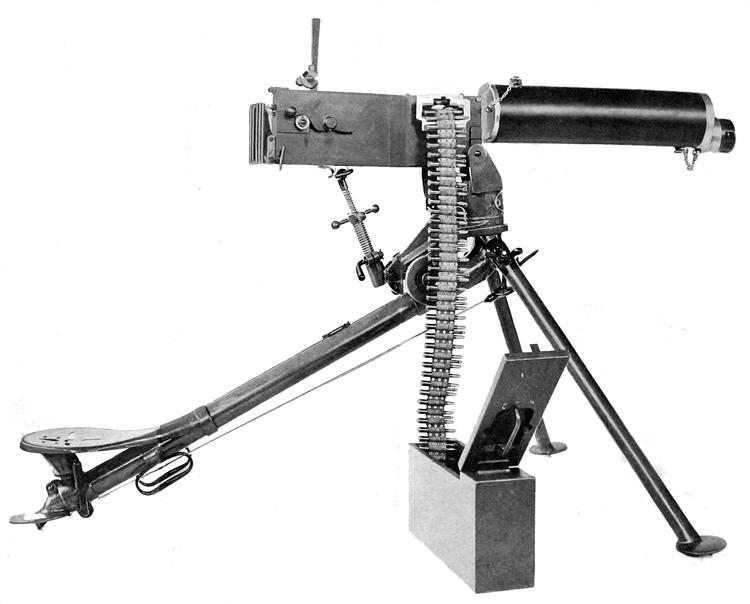
The U.S. Machine Gun
Maxim Model 1904 with ammunition box and 250 round belt of .30-03
cartridges loaded in the weapon.
In 1906 the machine gun platoon of the 22nd Infantry was created
and issued two of these guns. This was the first machine gun
issued to the 22nd Infantry with the designed purpose of becoming
an organizational part of the Regiment.
Photo from US Warhorse ~ The US Cavalry 1898 – 1920
Though the U.S. Army had
conducted trials with rapid fire weapons for many years it did
not adopt a machine gun
for universal issue to the Infantry and Cavalry until 1904. The
Gatling gun had been used since the Civil War but was
a large and heavy piece of equipment which had to be transported
by horse team or wagon and was therefore usually
relegated to Artillery units. The 22nd Infantry had utilized
Gatling guns in the Indian campaigns on a few occasions
but always only when on expeditions involving the use of wagons.
Parker Hitt in his memoirs mentioned having gained
combat experience with the Colt Model 1895 machine gun while
serving with the 22nd Infantry in the Philippines,
but the Colt gun was only issued on a limited and experimental
basis and was never an integral part of any Infantry unit.
On November 10, 1904 the Chief
of Ordnance adopted the Maxim machine gun Model 1900 for service
as the
U.S. MACHINE GUN MAXIM MODEL 1904. This became the first true
machine gun employed by the Army
with the purpose of becoming a normal component of all Infantry
and Cavalry organizations. War Department
General Orders No. 112 dated June 19, 1906 provided for the
establishment of a machine gun platoon for
one squadron of each regiment of Cavalry and one battalion of
each regiment of Infantry, to go into effect
on July 1, 1906. The authorized strength of the Army was
increased by 943 enlisted men to allow
for the creation of these new platoons.
In his report to the President
dated December 12, 1906 the Secretary of War explained that the
increase in
number of enlisted men authorized for the Army was needed for
these platoons:
 1
1
Compared to European armies the
U.S. Army was slow to recognize the value of adding machine guns
to the
inventory of weapons available to infantry and cavalry units. The
Secretary of War explained in his Annual Report
for 1906 why the creation of machine gun platoons was necessary
to develop the U.S. Army into a more modern
combat arm comparable to other world class armies:
 2
2
The Secretary went on to explain
why the new machine gun being adopted by the Army should be a
part of infantry
and cavalry units, as opposed to the artillery units such guns
had been relegated to during the years the Army
experimented with them:
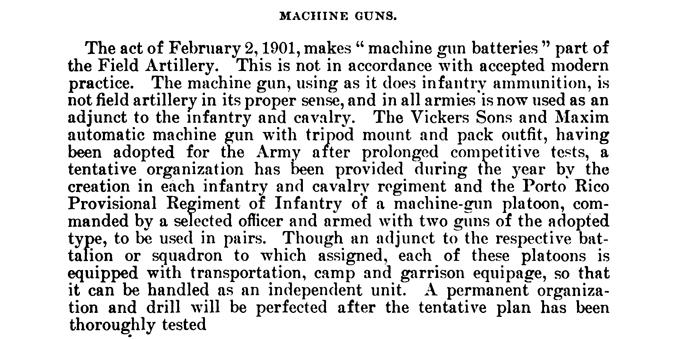 3
3
Headquarters 22nd Infantry
issued General Orders No. 14 dated July 1, 1906 creating the
machine gun platoon in 1st Battalion
22nd Infantry with 1st Lieutenant Henry A. Ripley of Company D
designated commander of the platoon.
Right: 22nd Infantry
General Orders No. 14 Webmaster's collection - -
Above: 1st LT Henry A. Ripley Photo from the Army-Navy Register |
|
The 22nd Infantry’s machine
gun platoon was issued two Maxim guns and consisted of one
officer, one sergeant and
two gun detachments, each gun detachment being comprised of one
corporal and nine privates. Company A provided
one sergeant and six privates; Companies B and C each furnished
one corporal and six privates. On October 29, 1906
Special Orders No. 99 from Headquarters 22nd Infantry named the
twenty-one enlisted men from 1st Battalion assigned
to the platoon and the 22nd Infantry machine gun platoon became
operational.
|
Left: Headquarters 22nd
Infantry With the creation of this order
the Webmaster's collection |
|
The Maxim Model 1904 as used by the U.S. Army and as issued to the 22nd Infantry |
Note the seat for the
gunner on the rear leg of the tripod. That long wire
looking thing mounted underneath the rear leg Photo from US Warhorse ~ The US Cavalry 1898 – 1920 |
The Maxim gun was a recoil
operated (with gas assist booster at muzzle) water cooled
belt-fed tripod-mounted weapon
in U.S. caliber .30-03. Rate of fire was 450-600 rounds per
minute and effective range was recommended by the
Ordnance Department as 1000 yards. The gun with water jacket
filled weighed just over 65 pounds and the tripod weighed
nearly 80 pounds. Ammunition was fed to the gun by a
non-disintegrating fabric belt which held 250 rounds and was
reloadable
with a special machine issued with each gun. The belt came in a
wooden ammunition box with folding carrying handle and
hinged cover. The same size boxes but with a tin lining inside
were used to carry water for the gun.
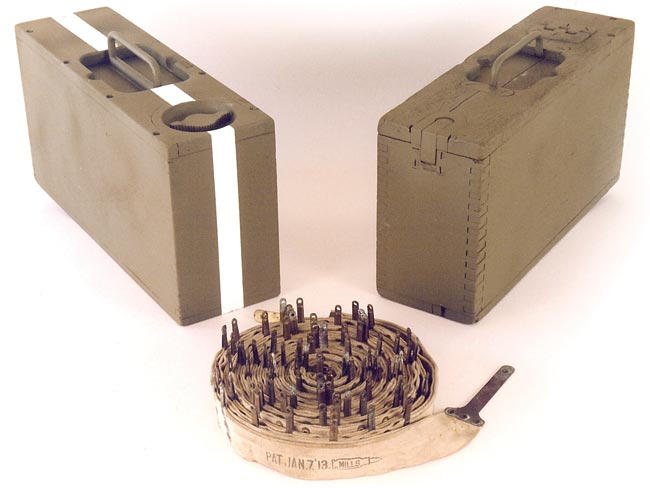
Left: water box, denoted
by its white painted stripe. Note filler cap. Right: ammunition
box with hinged cover.
Foreground: ammunition belt. Protruding metal studs on the belt
every third round aid in the feed mechanism.
Photo from the Small Arms Defense Journal website
|
The muzzle end of the Maxim gun. The large round gas booster The sights of the gun Photo from |
A total of 287 Maxim guns were
ordered by the Army. Vickers, Sons & Maxim Ltd. in England
manufactured the first 90 guns
with the rest being manufactured under license by Colt in the
U.S. The guns issued to the 22nd Infantry were made in England by
Vickers.
In 1906 the Army changed the
caliber of the service rifle from .30-03 to .30-06. During the
years 1906-1908 all of the 90 guns
made by Vickers were converted by U.S. arsenals to the new
caliber. Colt did not begin manufacture of the gun until 1908
and all of its guns were made in .30-06. All tripods were
manufactured by Vickers.
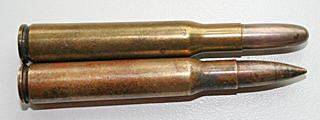
Top: .30-03 cartridge, bottom: .30-06 cartridge.
The .30-03 round fired a
220 grain round nose bullet at 2300 fps.
The .30-06 had a slightly shorter case neck and fired a 150 grain
pointed spitzer bullet at 2700 fps.
Photo from the Culver's Shooting Page webpage
The year the gun was adopted
there were no field manuals or training manuals for machine guns
in the U.S. Army
and no established doctrine on their employment or training with
them. In April 1906 the Army hurriedly printed its
first manual concerning machine guns. That manual consisted of 16
articles from European manuals which discussed
the tactical use and value of machine guns. The final article
which explained methods of training was translated from
the German by Captain Jacob Kreps of the 22nd Infantry.
Right: The first manual
printed by the Army It was nothing more than
reprints from |
|
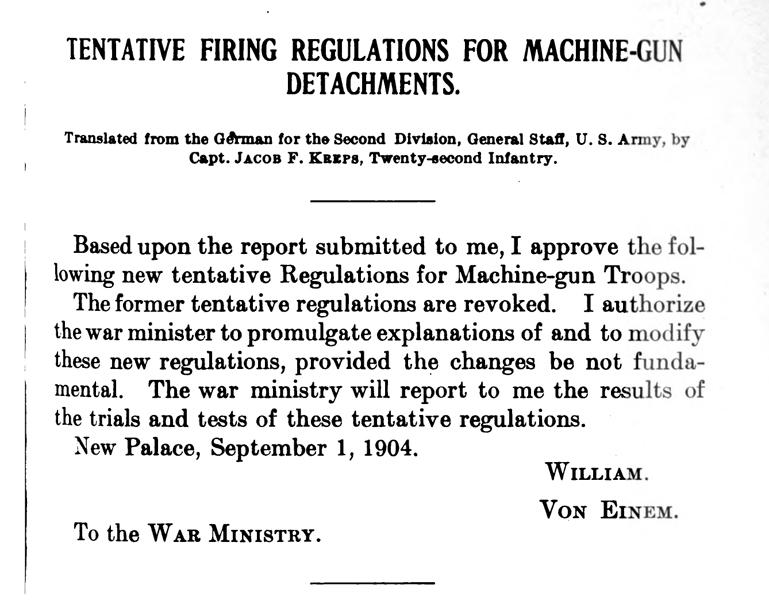
Above: The heading of
the article in the above manual concerning training with the
machine gun was a translation
of the report filed in 1904 with the Prussian Minister of War,
Karl von Einem under the reign of Kaiser Wilhem II (William.)
This was the final of 16 articles in the manual and was
translated from the German by Captain Jacob F. Kreps of the 22nd
Infantry.
The machine gun platoon of the
22nd Infantry was issued a single copy of the manufacturer’s
handbook on the assembly
and cleaning of the gun. In June 1906 the Army began printing its
own version of the handbook with photos and instructions
added concerning the transportation of the weapon and its
equipment on the pack mules. That handbook would be revised
four times over the next ten years. For several years after its
adoption initial use of the gun and training methods were left
to the development of each individual platoon.
In March 1907 the School of
Musketry of the Pacific Division was organized and established at
the Presidio of Monterey,
California. Company C, 22nd Infantry, officered by Captain P. W.
Davison, 1st Lieutenant E. W. Terry and 2nd Lieutenant
Dean Halford, and the regimental machine gun platoon under 1st
Lieutenant Henry A. Ripley, were detailed as a part of the
school cadre. The School of Musketry at the Presidio during that
time (1907-1913) is considered to be the forerunner of the
modern day Infantry School later established at Fort Benning,
Georgia.
In November 1907 1st Lieutenant
Parker Hitt from Company L assumed command of the 22nd Infantry
machine gun platoon
at the School of Musketry. He brought the machine gun platoon on
its first operational deployment in December 1907 when the
22nd Infantry was sent to Goldfield, Nevada in anticipation of
trouble in connection with a mining strike there. The expected
outbreak of violence during the strike did not occur and the guns
were not used in any confrontation. In February 1908
the machine gun platoon returned to the School of Musketry.
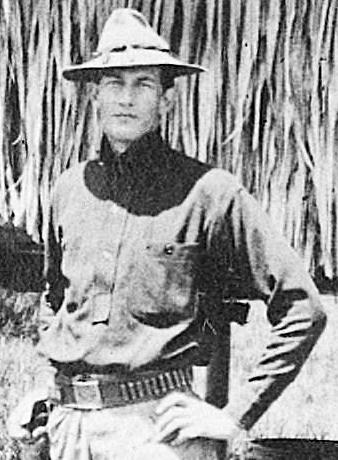
1st Lieutenant Parker
Hitt with the 22nd Infantry in the Philippines.
Hitt led the 22nd Infantry machine gun platoon at the School of
Musketry
and on the platoon's first operational deployment to Goldfield,
Nevada.
Photo from the Parker Hitt photograph collection, University of Michigan
Parker Hitt would become a
pioneer in the creation of machine gun doctrine for the Army. The
autonomy given to him with regard
to formulating training methods and in developing the use of the
machine gun was unheard of at the time for an officer of his
rank.
Hitt found he could “push the envelope” with regard to
developing doctrine and had no reservations about expending
ammunition
to test out new theories. Any suggestion made by his men in the
platoon was tested through actual firing of the guns. The
Ordnance
Department mandated an allowance of 500 rounds per gun per year
for training but in 1907-1908 Hitt exceeded that by expending
20,000 rounds per gun through each of his two guns. He recognized
the need for extended firing of the gun in training beyond
the limited allowance of the Ordnance Department. In his reports
to the Army his recommendations of such were accepted
and became employed at other schools and firing ranges.
Hitt ran the 22nd Infantry
machine gun platoon through trials and testing to actually invent
drill regulations, firing regulations
and field service regulations for his machine guns. He
experimented with indirect fire, night firing, sighting and
improvising
mechanical additions to the gun and its tripod. Hitt was one of
the first to experiment with field targets which would stand
in a wind but fall when struck by a bullet. He devised a rotary
target which would fall when struck and automatically bring up
a new target. The Ordnance Department even manufactured his
rotary target for some time.
One problem Hitt noticed from
the water cooled guns was the issue of steam emanating from the
gun after continued firing.
The water jacket had a small steam condensing vent at the front
of the gun to allow steam to escape from the jacket as the
water in it got heated by the hot barrel. If the gun was fired
continuously for several hundred rounds the amount of steam
created
was quite large, sending a white plume of steam several feet
straight up into the air, obscuring the gunner’s sighting
and calling
attention to the gun’s location on the battlefield.
One day when this happened Hitt
got a piece of rubber hose and inserted one end of it into the
steam vent and the other end
into a water box on the ground. The adaptation immediately
eliminated the tall plume of steam. Hitt developed a leather
strap
arrangement with chain and hook to hold the hose away from the
gun and form a loop in the hose to keep it from binding
when the gun was traversed. He recommended the device to the War
Department by letter in March 1908.
In July 1909 Brigadier General
William Crozier, Chief of Ordnance for the Army directed that all
Maxim guns in the Army
be supplied with Hitt’s device. Crozier’s directive
mentioned LT Hitt and the 22nd Infantry as the originator of the
idea.
Parker Hitt's assembly was added in further revisions of the
Army’s handbook for the Maxim gun as part No. 161, the
“steam condensing device”. The device was also used on
the Vickers/Colt machine gun introduced in 1915 and subsequently
on the Browning Model 1917 machine gun which later became the
standard water cooled machine gun of the U.S. Army
beginning in 1918 and continuing through the Korean War.
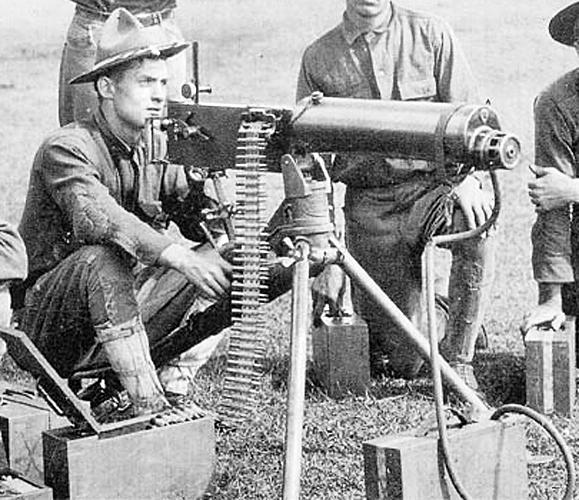
A Maxim gun of the 2nd
Infantry fitted with Hitt's steam condensing device ca. 1917.
The hose (or tubing) comes down from the steam vent of the water
jacket and is looped
by a leather strap and chain hanging attachment, continuing on
down into the water box
through the filler cap. Note painted white stripe on water boxes.
Photo from the Small Arms Defense Journal website
As one of the first units in the
Army to be issued machine guns as an integral part of the
Regiment’s inventory
the 22nd Infantry machine gun platoon under the leadership of 1st
Lieutenant Parker Hitt led the way in the development
of training doctrine and field tactics in the employment of
modern weaponry for the battlefield.

The two Maxim guns of the machine gun
platoon of the 22nd Infantry, at Goldfield, Nevada December 1907.
Note these guns taken to Goldfield by the 22nd did not yet have
Hitt's modification of the steam condensing hose.
Photo from the P.E. Larson Collection, courtesy
of the
Nevada State Museum, Carson City, Nevada
Nevada Department of Cultural Affairs
The Maxim gun was transported by
pack mules utilizing special harnesses and pack frames. Five
mules were authorized per gun.
The first mule carried the gun in a leather case, the tripod
folded up, a pick mattock and several shovels. The remaining
four mules each carried ammunition and water boxes along with gun
tools, accessories, the belt filling machine, spare barrel
and parts, picket posts and other tools such as a sledge hammer.
Recommended total ammunition load carried by all the mules
together came to 7000 rounds per gun.
In the Annual Report of the War
Department for 1904 the tests concerning machine guns conducted
during 1903-1904
were recorded, along with the statement that the recommendation
of the testing board that the Maxim machine gun be
adopted was approved by the Secretary of War on November 10,
1903. One year later the Maxim gun would officially
be adopted for service, on November 10, 1904.
Note in the passage below from
that 1904 report that the first 90 guns were already being
manufactured and note also
the suggestions made for transporting the gun and its associated
ammunition and components on pack mules. The final
line records that 40 Gatling guns had been procured during the
year in the caliber of the service rifle of the time.
(The Gatling gun would not be officially retired from the Army
until 1911.)

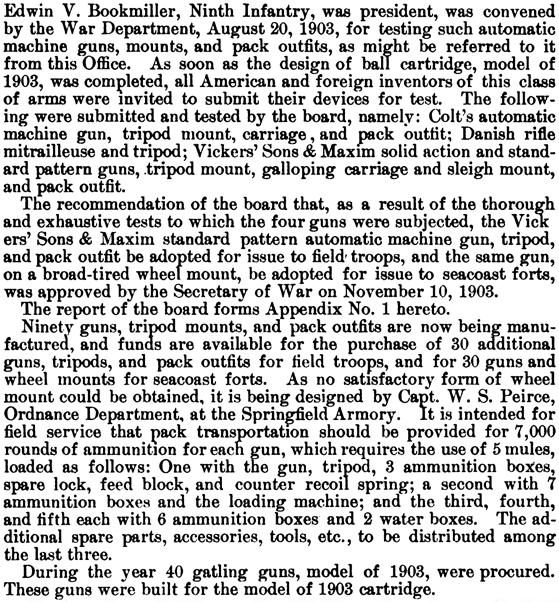 4
4
Below are scans from the
handbook for the Maxim gun as issued to Army machine gun
platoons.
This version of the handbook is the fourth revision, printed in
1917. As can be seen by the title page
the handbook was first printed in June 1906.
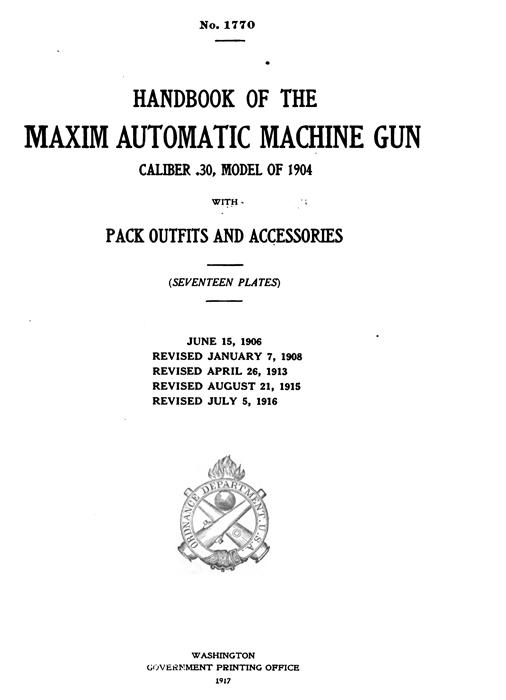
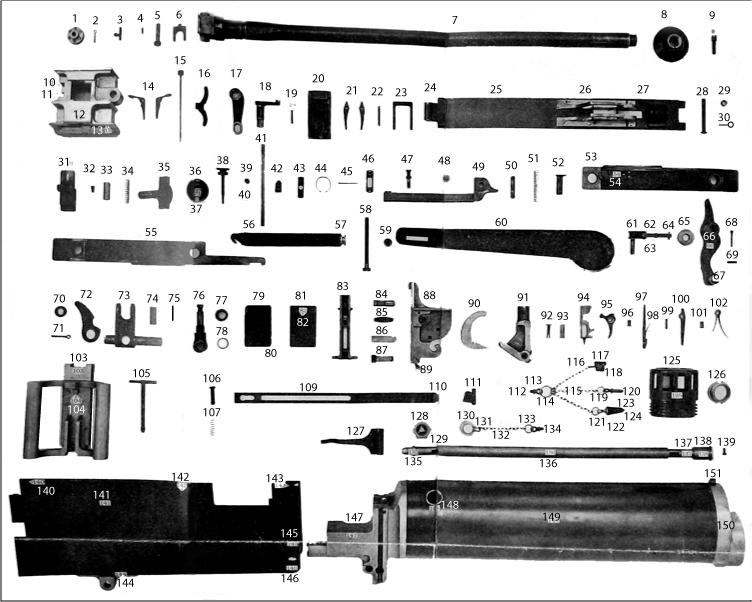
Above: the Maxim gun broken down into its component parts
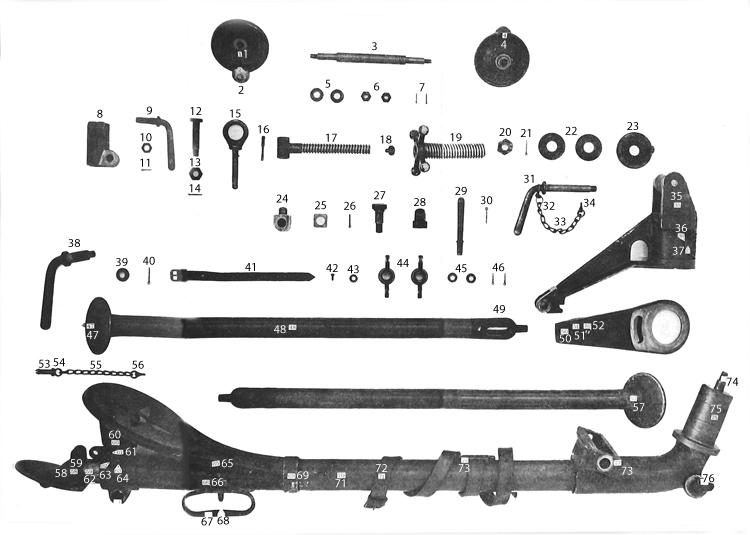
Above: the tripod broken down into its component parts
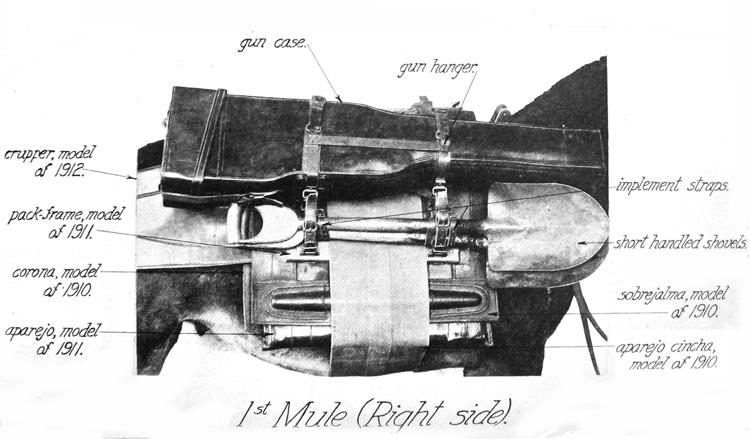
Above: suggested load for the first pack mule (right side). Note the leather case for the gun.
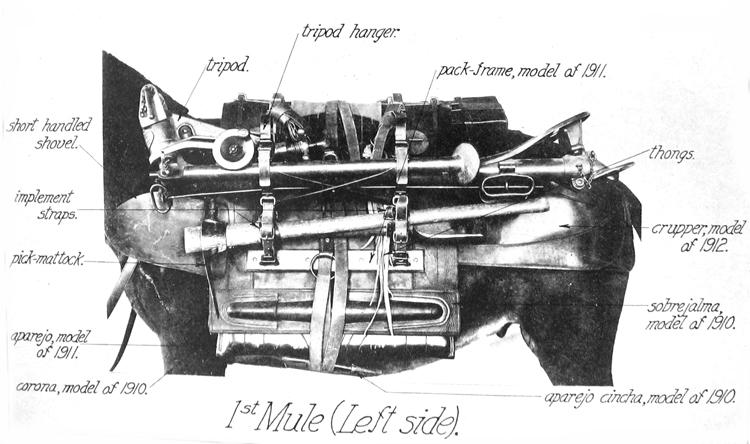
Above: suggested load for the first pack mule (left side). The tripod is folded up.
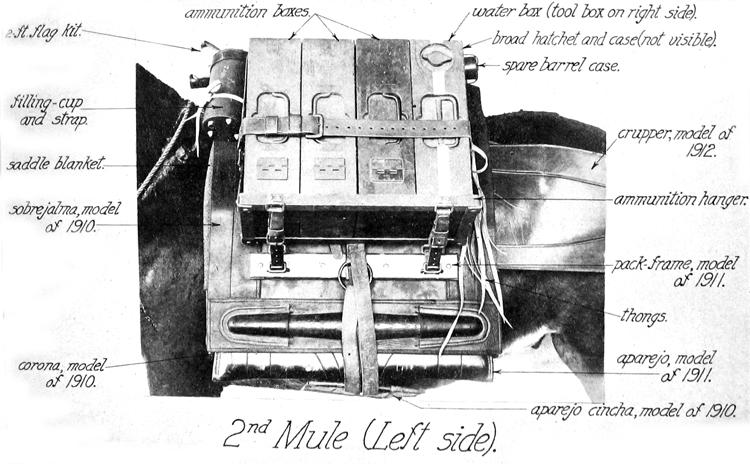
Above: the suggested load of the second
pack mule (left side). Note the frame for carrying the
ammunition and water boxes.
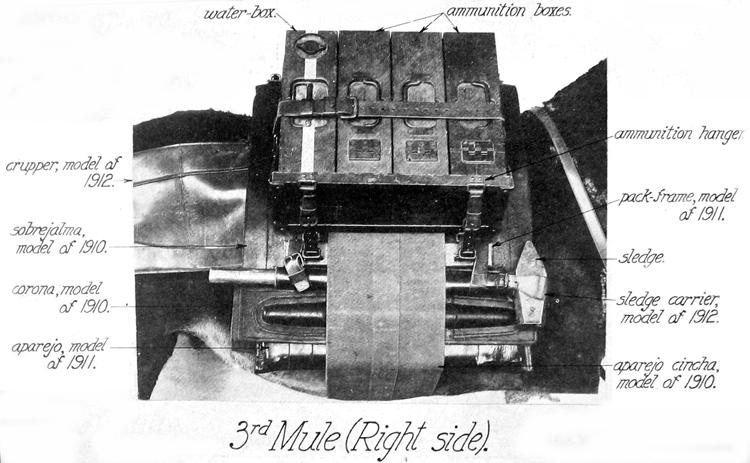
Above: the suggested load for the third pack mule (right side).
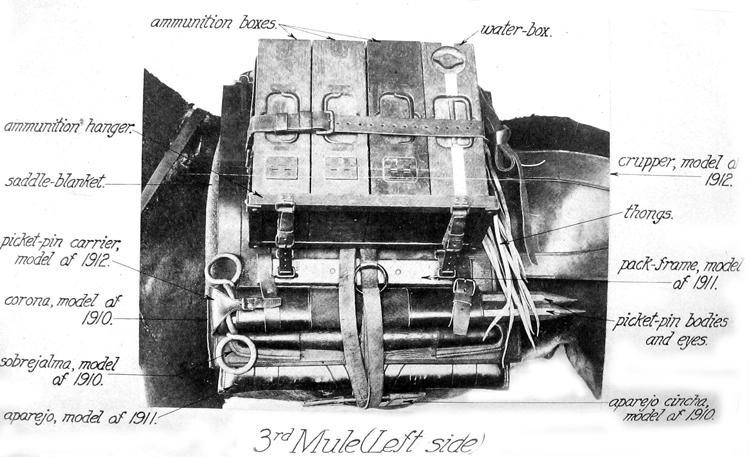
Above: the suggested load for the third pack mule (left side).
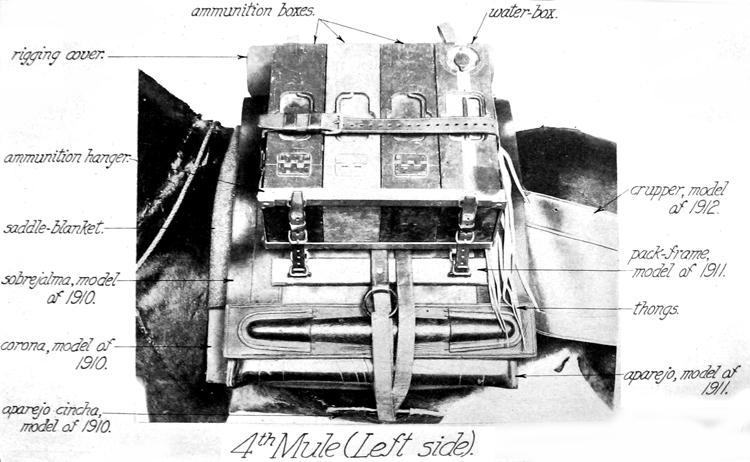
Above: the suggested load for the fourth pack mule (left side).
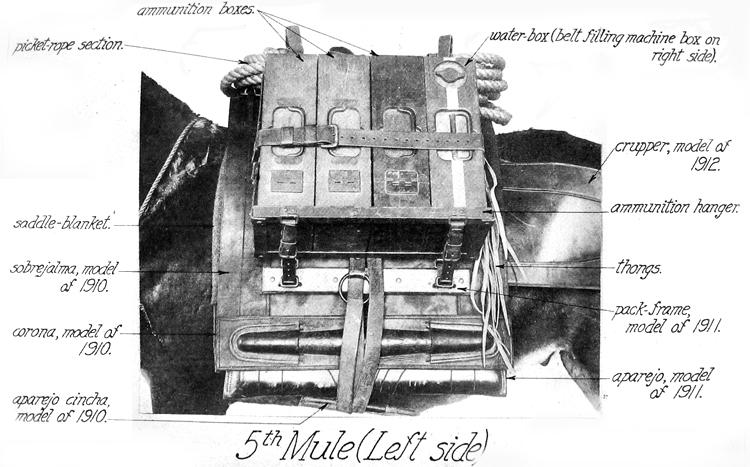
Above: the suggested load for the fifth pack mule (left side).
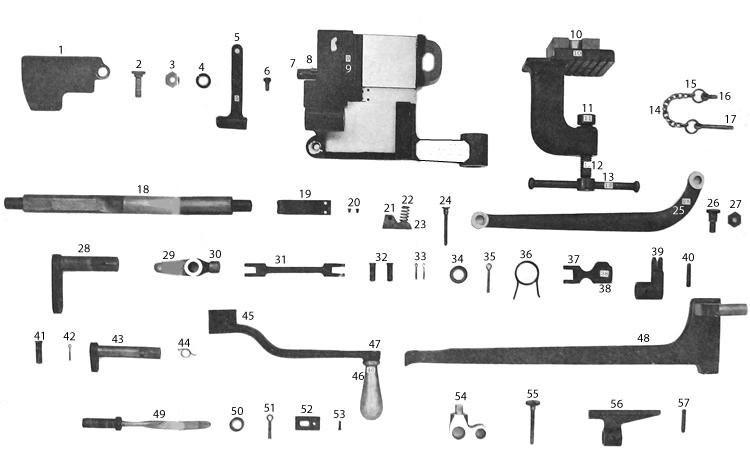
Above: the belt filling machine broken down into its component parts.
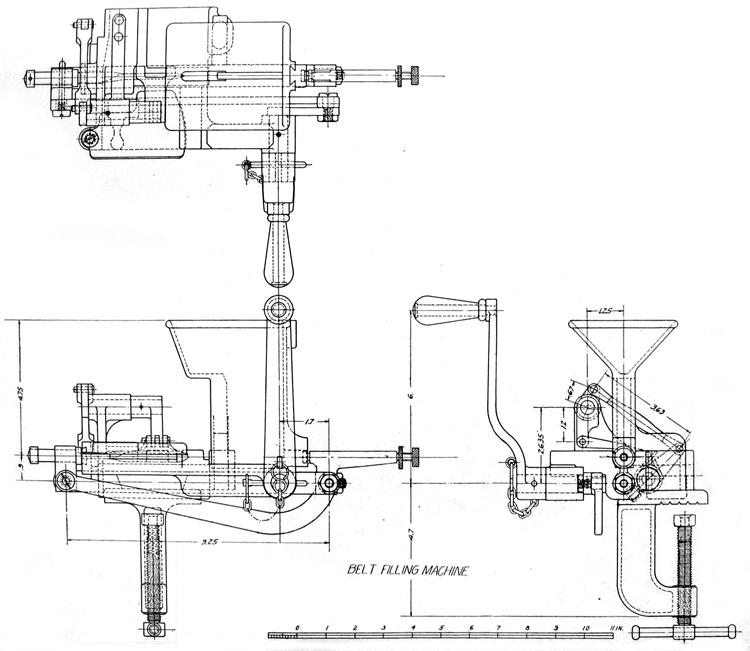
Above: schematic drawing of the belt filling machine.
Cartridges dropped one at a time from
the hopper and were pushed into the cloth belt loops
as the belt was advanced, the whole process being operated by
turning the hand crank.
The "C" clamp held the machine to a table or to the
wooden storage box for the machine.
| Footnotes: 1---- THE
ABRIDGMENT 1906 CONTAINING THE ANNUAL MESSAGE OF THE
PRESIDENT OF THE UNITED STATES TO 2 ----Ibid., pp. 330 3 ----Ibid., pp. 465 4 ----ANNUAL REPORTS OF
THE WAR DEPARTMENT FOR THE FISCAL YEAR ENDED JUNE 30,
1904. •VOLUME II. |
To hear the sound of an authentic Maxim machine gun firing click on the photo immediately below:
(Note: The link is to an
audio file. Depending upon what browser you use
the file may not automatically open. You may need to manually
open the
file to listen to it. Be aware that some browsers such as Google
Chrome
may actually place the file in your downloads folder.)
Members of the First Connecticut Field
Company Machine Gun Troop, Fifth Cavalry, fire the U.S. Maxim
Model 1904
along the Mexican boarder circa 1916 in this hand colored photo
postcard.
Photo from the Small Arms Defense Journal website
Windows audio file of the same basic model of Maxim gun as the Model 1904 firing taken from the You Tube video The Maxim Machine Gun
Home | Photos | Battles & History | Current |
Rosters & Reports | Medal of Honor | Killed
in Action |
Personnel Locator | Commanders | Station
List | Campaigns |
Honors | Insignia & Memorabilia | 4-42
Artillery | Taps |
What's New | Editorial | Links |